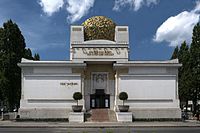Top: Secession Building in Vienna designed by Joseph Maria Olbrich (1897–1898); Bottom: Excerpts of the Beethoven Frieze by Gustav Klimt (1902) | |
| Years active | c. 1897–1914 |
|---|---|
| Location | Austria |
| Major figures | Gustav Klimt, Joseph Maria Olbrich, Josef Hoffmann, Otto Wagner |
| Influences | Art Nouveau |
The Vienna Secession (German: Wiener Secession; also known as the Union of Austrian Artists or Vereinigung Bildender Künstler Österreichs) is an art movement, closely related to Art Nouveau, that was formed in 1897 by a group of Austrian painters, graphic artists, sculptors and architects, including Josef Hoffman, Koloman Moser, Otto Wagner and Gustav Klimt.[1] They resigned from the Association of Austrian Artists in protest against its support for more traditional artistic styles. Their most influential architectural work was the Secession exhibitions hall designed by Joseph Maria Olbrich as a venue for expositions of the group. Their official magazine was called Ver Sacrum (Sacred Spring, in Latin), which published highly stylised and influential works of graphic art. In 1905 the group itself split, when some of the most prominent members, including Klimt, Wagner, and Hoffmann, resigned in a dispute over priorities, but it continued to function, and still functions today, from its headquarters in the Secession Building. In its current form, the Secession exhibition gallery is independently led and managed by artists.[2]
- ^ Heller, Reinhold (March 1977). "Recent Scholarship on Vienna's "Golden Age," Gustav Klimt, and Egon Schiele". The Art Bulletin. 59 (1): 111–118. doi:10.2307/3049602. JSTOR 3049602 – via JSTOR.
- ^ "Building". Vienna Secession. Retrieved 11 November 2023.

